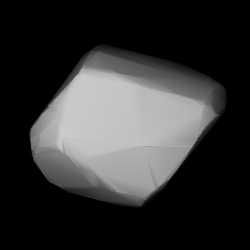Astronomy:1637 Swings
 Shape model of Swings from its lightcurve | |
| Discovery[1] | |
|---|---|
| Discovered by | J. Hunaerts |
| Discovery site | Uccle Obs. |
| Discovery date | 28 August 1936 |
| Designations | |
| (1637) Swings | |
| Named after | Pol Swings (astrophysicist)[2] |
| 1936 QO · 1907 YT 1934 FL · 1934 FP 1936 SD · 1939 FU 1950 GA | |
| Minor planet category | main-belt · (outer) |
| Orbital characteristics[1] | |
| Epoch 4 September 2017 (JD 2458000.5) | |
| Uncertainty parameter 0 | |
| Observation arc | 109.78 yr (40,096 days) |
| |{{{apsis}}}|helion}} | 3.2088 AU |
| |{{{apsis}}}|helion}} | 2.9356 AU |
| 3.0722 AU | |
| Eccentricity | 0.0445 |
| Orbital period | 5.38 yr (1,967 days) |
| Mean anomaly | 123.47° |
| Mean motion | 0° 10m 58.8s / day |
| Inclination | 14.068° |
| Longitude of ascending node | 21.288° |
| 236.17° | |
| Physical characteristics | |
| Dimensions | 45.15 km (IRAS)[3] 52.994±0.428 km[4] |
| Geometric albedo | 0.042±0.004[4] |
| Absolute magnitude (H) | 10.4[1] |
1637 Swings, provisional designation 1936 QO, is a dark asteroid from the outer region of the asteroid belt, approximately 50 kilometers in diameter. Discovered by Joseph Hunaerts in 1936, it was named after Belgian astronomer Pol Swings.
Discovery
Swings was discovered on 28 August 1936, by Belgian astronomer Joseph Hunaerts at the Royal Observatory of Belgium in Uccle, Belgium.[5] In the following month, it was independently discovered by astronomer Cyril Jackson at Johannesburg Observatory in South Africa.[2]
Orbit and classification
The asteroid orbits the Sun in the outer main-belt at a distance of 2.9–3.2 AU once every 5 years and 5 months (1,967 days). Its orbit has an eccentricity of 0.04 and an inclination of 14° with respect to the ecliptic.[1] In 1907, Swings was first identified as 1907 YT at Heidelberg Observatory. However, the body's observation arc begins with its official discovery observation at Uccle in 1936.[5]
Physical characteristics
According to the surveys carried out by the Infrared Astronomical Satellite IRAS and NASA's Wide-field Infrared Survey Explorer with its subsequent NEOWISE mission, Swings' surface has an albedo of 0.042, and measures 45.15 and 52.99 kilometers in diameter, respectively.[3][4] It has an absolute magnitude of 10.4.[1]
As of 2017, the body's spectral type, rotation period and shape remain unknown.[1]
Naming
This minor planet was named after Pol Swings (1906–1983), a Belgian astrophysicist, astronomer and president of the International Astronomical Union during 1964–1967, who significantly contributed to the understanding of the physics of comets and their spectra.[2] The official naming citation was published by the Minor Planet Center on 20 February 1976 (M.P.C. 3932).[6]
References
- ↑ 1.0 1.1 1.2 1.3 1.4 1.5 "JPL Small-Body Database Browser: 1637 Swings (1936 QO)". Jet Propulsion Laboratory. https://ssd.jpl.nasa.gov/sbdb.cgi?sstr=2001637.
- ↑ 2.0 2.1 2.2 Schmadel, Lutz D. (2007). "(1637) Swings". Dictionary of Minor Planet Names – (1637) Swings. Springer Berlin Heidelberg. p. 130. doi:10.1007/978-3-540-29925-7_1638. ISBN 978-3-540-00238-3.
- ↑ 3.0 3.1 Tedesco, E. F.; Noah, P. V.; Noah, M.; Price, S. D. (October 2004). "IRAS Minor Planet Survey V6.0". NASA Planetary Data System – IRAS-A-FPA-3-RDR-IMPS-V6.0. Bibcode: 2004PDSS...12.....T. https://sbnarchive.psi.edu/pds3/iras/IRAS_A_FPA_3_RDR_IMPS_V6_0/data/diamalb.tab. Retrieved 17 October 2019.
- ↑ 4.0 4.1 4.2 Masiero, Joseph R.; Mainzer, A. K.; Grav, T.; Bauer, J. M.; Cutri, R. M.; Dailey, J. et al. (November 2011). "Main Belt Asteroids with WISE/NEOWISE. I. Preliminary Albedos and Diameters". The Astrophysical Journal 741 (2): 20. doi:10.1088/0004-637X/741/2/68. Bibcode: 2011ApJ...741...68M. http://adsabs.harvard.edu/cgi-bin/bib_query?bibcode=2011ApJ...741...68M. Retrieved 27 December 2016.
- ↑ 5.0 5.1 "1637 Swings (1936 QO)". Minor Planet Center. https://www.minorplanetcenter.net/db_search/show_object?object_id=1637.
- ↑ Schmadel, Lutz D. (2009). "Appendix – Publication Dates of the MPCs". Dictionary of Minor Planet Names – Addendum to Fifth Edition (2006–2008). Springer Berlin Heidelberg. p. 221. doi:10.1007/978-3-642-01965-4. ISBN 978-3-642-01964-7. https://archive.org/details/dictionaryminorp2008schm.
External links
- Asteroid Lightcurve Database (LCDB), query form (info )
- Dictionary of Minor Planet Names, Google books
- Asteroids and comets rotation curves, CdR – Observatoire de Genève, Raoul Behrend
- Discovery Circumstances: Numbered Minor Planets (1)-(5000) – Minor Planet Center
- 1637 Swings at AstDyS-2, Asteroids—Dynamic Site
- 1637 Swings at the JPL Small-Body Database
 |

